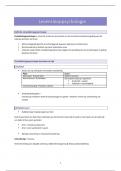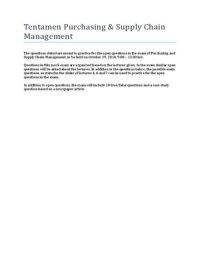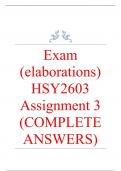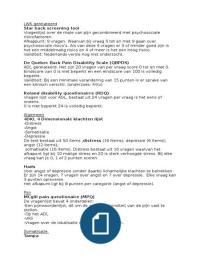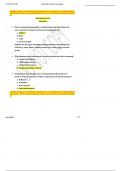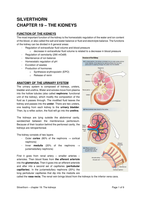Strategy
&
Organisation
Summary
Marketing
S trategy
&
O rganisation
Building
Sustainable
Business
Rudy
Moenaert
&
Henry
Robben
7th
Edition
Lannoo
Campus
1
,Chapter
1
The
Business
Roadmapping
Cycle
Definition
marketing:
‘marketing
is
building
sustainable
business’
• Business:
the
objective
of
marketing
is
to
realize
organizational
goals,
through
the
change
of
offerings
(goods
and
services)
with
customers;
• Sustainable:
to
ensure
the
survival
of
the
company
as
going-‐concern,
value
must
be
created
for
the
company
as
well
as
for
the
customer;
• Building:
the
performance
of
a
company
is
the
result
of
the
integrated
efforts
of
the
whole
organization.
3
key
questions
regarding
strategy:
1. Where
are
now?
2. Where
do
we
want
to
be?
3. How
do
we
get
there?
Definition
strategic
marketing:
strategic
marketing
relates
to
the
planning
and
the
implementation
of
marketing
activities
in
order
to
optimize
the
company’s
current
and
future
competitiveness.
Business
road
mapping
2
,Chapter
2
Understanding
the
business
Defining
the
Business
• ‘The
marketer
must
analyze
the
internal
and
external
environments
of
the
company
–
the
most
important
is
around
its
customers’:
o the
customer
value
proposition
o the
business
model
o the
industry
and
macro-‐environments
in
which
it
competes
• The
Abell
Framework
(choice
between
3
dimensions
=
strategic
positioning):
o The
customer
groups
a
business
unit
serves
(‘who’)
o The
functions
its
offering
fulfills
for
these
customer
groups
(‘what’)
o The
technologies
that
are
deployed
to
realize
these
functions
(‘how’)
3
,Customer
Analysis
(‘Who’)
• Way-‐to-‐Market
Analysis
o This
analysis
shows
how
the
company
gets
its
goods
and
services
to
the
end-‐user,
as
well
as
highlighting
the
go-‐betweens
and
their
relationships.
o Critical
question:
‘who
is
the
focal
customer
on
which
the
customer
should
concentrate?’
§ ‘Who
makes
the
choices?’
§ ‘Who
pays?’
§ ‘Who
consumes?’
• The
Needs
of
the
Customer
o Define
markets
as
‘the
job
to
be
done’
instead
of
‘the
product
to
be
sold’
o Marketers
must
recognize
that
the
important
thing
is
what
their
goods
and
services
do
for
their
customers.
o 3
customer
needs:
§ Functional
needs
§ Experiential
needs
§ Symbolic
needs
4
, • Customer
Segmentation
o Definition
segment:
§ a
segment
consists
of
a
group
of
individuals
(customer
marketing)
or
organizations
(business-‐to-‐business)
that
share
one
or
more
characteristics,
making
them
have
similar
needs.
o The
segmentation
process:
§ Create
segments
based
on
customer
needs
§ Then
label
each
segment
using
profiling
variables:
• For
the
consumer
market:
o geographic,
behavioral,
psychographic,
demographic
variables
• For
the
industrial
market:
o Step
1:
macro-‐segmentation
based
on
demographic
and
industrial
criteria
o Step
2:
micro-‐segmentation
based
on
characteristics
of
the
decision-‐making
units
of
the
customers
o Good
segmentation
criteria:
§ Substantial:
cluster
target
market
in
a
broad
yet
comprehensive
set
of
separate
customer
groups
§ Measurable:
you
must
be
able
to
measure
the
segment
§ Differentiable:
different
segments
will
react
differently
to
different
elements
in
a
company’s
marketing
strategy
§ Actionable:
you
must
be
able
to
formulate
an
appropriate
marketing
strategy
for
each
segment
§ Challenge
yourself
and
try
to
think
differently
o Segments
change
over
time
• Targeting
o Definition
targeting:
decision
to
select
particular
segments
to
focus
on
o Criteria
for
determining
attractive
segments:
§ Size
of
the
segment
§ Growth
rate
of
the
segment
§ Structural
attractiveness
of
the
segment
5
,Customer
Value
Proposition
(‘What’)
• Definition
Customer
Value
Proposition
o Customer
Value
Proposition:
§ Bringing
together
the
view
of
the
customer
and
the
view
of
the
company:
the
set
of
company’s
competitive
advantages
in
a
given
customer
segment
o 4
Scope
strategies:
ways
of
differentiating
a
company’s
offering
from
the
offerings
of
the
competition:
§ Non-‐segmentation
strategy:
• A
single
customer
value
proposition
which
is
marketed
to
all
the
selected
target
segments
§ Segmentation
strategy:
• The
company
has
different
customer
value
proposition
for
each
of
the
selected
target
segments
§ Niche
strategy:
• The
company
identifies
one
segment
and
develops
a
customer
value
proposition
for
that
segment
§ Customization
strategy:
• The
offering
is
adapted
for
each
and
every
customer
via
pure
customization
or
standardized
customization.
o Definition
competitive
advantage:
§ a
strength
possessed
by
an
organization
that
influences
the
decision-‐making
process
of
the
customer
in
favor
of
that
organization.
• Winning
in
the
Market
o Having
a
competitive
advantage
is
essential
for
winning
in
the
business
world
o Critical
success
factors
(CSF):
§ Definition:
variables
that
management
can
influence
and
that
determine
the
competitive
position
of
the
company
in
the
industry
§ 2
types
of
critical
success
factors:
• ‘Tickets
to
ride’:
necessary
requirements
for
an
organization
to
compete
in
a
certain
market
• ‘Tickets
to
heaven’:
enables
the
company
to
clearly
distinguish
itself
from
its
rivals
–
the
edge
over
the
competition
§ 11
critical
success
factors:
• Image
• Reliability
• Thinking
with
the
customer
6
, • Relationship
• Knowledge
• Price
• Quality
• Flexibility
• Speed
• Innovativeness
• Resources
§ A
company
must
not
try
to
excel
at
every
CSF;
Aaker
claims
that
successful
companies
possess
on
average
4
to
5
competitive
advantages
§ A
company
that
chooses
to
focus
on
a
selected
number
of
customer
benefits
has
the
following
options:
be
better,
be
different
or
be
both.
• The
CODA
framework
o Definition
CODA:
§ Customer’s
Outlook
on
Differentiating
Advantages
o 4
types
of
competitive
advantage:
§ Offering:
‘what
do
you
offer?’
–
the
functional
core
benefits
that
the
product
or
service
offers
to
the
customer
§ Customer
Process:
‘how
and
where
do
you
offer
it?’
–
through
interactions
between
the
organization
and
its
customers,
the
organization
identifies,
builds
and
maintains
relationships
as
well
as
delivering
its
offering.
§ Price:
‘what
are
the
costs
to
the
customer?’
–
the
financial
and
non-‐financial
costs
a
customer
incurs
when
buying,
using
or
possessing
a
service
or
products.
§ Image:
‘what
do
you
represent?’
–
the
awareness,
beliefs,
ideas
or
impressions
that
the
customer
holds
about
an
organization
and
its
offering.
§ Rejection
of
Porter’s
framework
(differentiation
vs
low-‐
cost):
• Companies
are
able
to
pursue
more
complex
strategies
• Marketers
need
to
adopt
a
customer
perspective
in
conceptualizing
competitive
differentiation.
7
, The
Business
Model
(‘How’)
• Resource
Configuration
for
Competitive
Advantage
o Resource
based
view
(Hamel
&
Prahalad):
§ A
competitive
advantage
does
not
arise
from
having
a
position
in
an
attractive
market,
but
rather
from
an
effective
use
of
resources
in
the
chosen
target
market
o Activity
system
=
‘business
model”
(Porter)
§ Definition
business
model:
• The
configuration
of
resources
that
enables
a
company
to
create
and
deliver
the
customer
value
proposition
for
a
market
segment
• Assumption:
companies
with
a
clear
strategic
position
can
identify
a
number
of
higher-‐order
strategic
themes
• These
higher
order
themes
are
factors
at
which
the
company
wishes
to
excel
by
executing
clusters
of
tightly
linked
activities
=
competitive
advantages
of
the
customer
value
proposition
§ Benefits
business
model:
• Allows
for
a
systematic,
rational
and
thorough
analysis
of
value
creation
• Can
be
adapted
for
analyzing
all
types
of
organizations
• Is
visually
attractive
and
therefore
making
communication
easier
• Easier
to
understand
and
to
implement
§ Classification
of
resources
that
enable
a
customer
value
proposition
• Tangible
resources
(human
resources,
patents,
etc.)
vs
intangible
resources
(know-‐how,
experience,
culture,
etc.)
• Assets
vs
processes
• Business
Model
implications
o You
can
only
create
a
business
model
when
you
have
identified
the
focal
customer
and
the
way-‐to-‐market
architecture
o Principle
that
a
company
has
to
earn
its
competitive
advantages
o Never
take
a
company’s
competitive
advantages
for
granted
–
you
have
to
manage
o Every
organization
has
a
business
model
o Always
look
for
embedded
secondary
value
propositions
o Check
whether
business
models
from
business
units
align
with
the
corporate
strategy
&
use
to
assess
operational
fit
of
mergers
and
acquisitions
8


